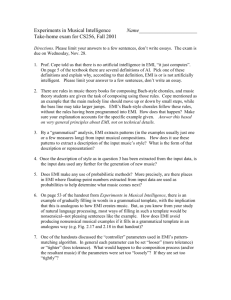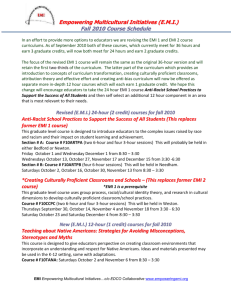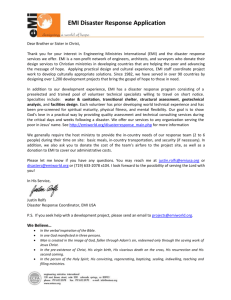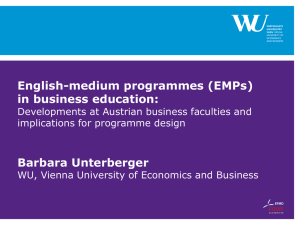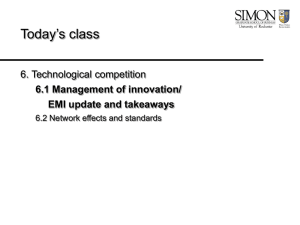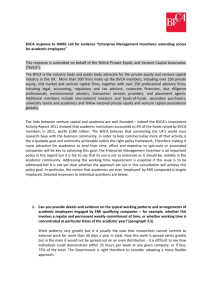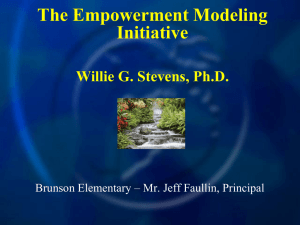Language Centre EMI
advertisement
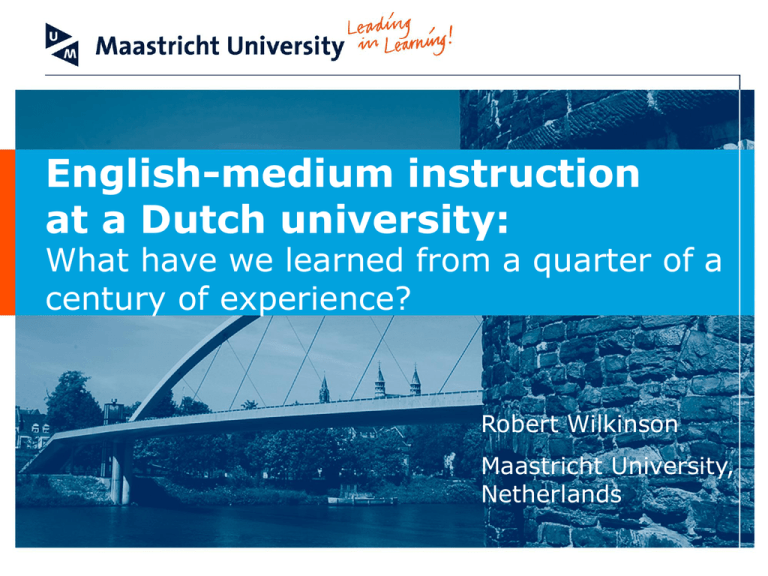
English-medium instruction at a Dutch university: What have we learned from a quarter of a century of experience? Robert Wilkinson Maastricht University, Netherlands EMI at a Dutch university: overview • Evaluating 25 years of experience – EMI perspectives and phases – EMI and domain loss (national vs. local) – Curriculum & course design – Teaching quality – Collaboration – Conclusions Language Centre EMI: perspectives • Globalization & demographics • Domain loss • Trading practices in HE Language Centre Evaluating: phases of EMI Cross-border European1987 ization 1991 GlobalizConsolidation ation 1995 2002 Monetization 2007 Motivations recruitment (internat. & exch. students) Practical geography Idealist multilingualism Educational new new programmes programmes Survival Financial Language Centre home market (small/ saturated) recruitment recruitment (student (money) expertise) international.at-home new programmes profile (bilingual) cost of biling. options profile (internat.) profile (rankings) recruitment (bring in money) Domain loss • EMI → domain loss for L1 (e.g. Ammon, 2008; Brock-Utne, 2007; Phillipson, 2003; etc.) • EMI: prestige functions of social communication • Spread to other social spheres (e.g. Janssens & Marynissen, 2005) • Reduced creativity in L1 Language Centre Domain loss • Favourable treatment of English/inequitable treatment of L1 (e.g. Brock-Utne, 2007; van Parijs, 2004) • Employability issues: can EMI graduates function in L1? (e.g. Melis, 2010) Language Centre Domain loss • Arises because of hegemony of nationstate (e.g. Brutt-Griffler, 2008) • Nation-states promote advance of English (foreign language teaching in schools) (e.g. Grin, 2002) • National vs. individual institution Language Centre An individual Dutch university: EMI • • • • • • Attractiveness to students Strengthening of revenue stream Widening recruitment pool Success breeds success Recognition Students: positioning themselves for job market • Students: quality of programme & teaching Language Centre Curriculum & course design • Course design: – rationale/philosophy, learning goals, content selection, teaching/learning methods, learner factors (e.g. motivation), learning context • Content selection: – Is programme new or conversion from L1 programme? (EPH or Economics) – Are disciplines nationally culturally determined or relatively independent of national culture? (ES or KE) Language Centre Curriculum & course design: EMI • Broad themes • In-depth study for student • No explicit demand to seek material other than in English • General theories, principles • General applications irrespective of national context • Narrow depth vs. shallow breadth Language Centre Teaching quality: EMI • Lecturing puts onus on teaching staff – Pronunciation – Lack of clarity – Linguistic flexibility, nuances – Spontaneous exemplification – (e.g. Vinke, 1995, 2010; Klaassen, 2001) • Language: no long-term effect on learning Language Centre Teaching quality: EMI • Student-centred learning, e.g. PBL – Emphasis on students’ responsibility for own learning • Plan learning, determine interaction, research & assess own learning – Active language use – Lessens reliance of staff language ability – Development vs. stabilization or fossilization Language Centre Collaboration between content & EAP staff • Expectations – Students: quality of content, content knowledge & language development – Content staff: stimulate learning of subject matter; not develop language ability Language Centre Collaboration between content & EAP staff • EAP staff: monitor, support, instruct – Academic literacies (esp. writing) – Language enhancement – Knowledge of content curriculum (knowledge structure) – Team-teaching → parallel/adjunct teaching Language Centre Quality: EMI • EMI: initial negative effect on understanding, no long-term effect • No effect on learning outcomes • Signs of positive effect on learning process • Slight negative effect on teachers’ teaching, no relation with student outcomes • Time-consuming and tiring on teaching staff • Quality of students’ English related to amount of time in English • Minor pronunciation problems can lead to strong negative reactions from students • (Vinke, 2010; de Bot, 2011) Language Centre Conclusions • EMI – positive outcomes if well designed • EMI – economic benefits to institution and to student (e.g. Grin, 2002; van Parijs, 2004) • English as commodity • Differentiation need will grow Language Centre Conclusions • EMI at national level – Domain loss or domain adaptation – Funding issues: taxpayer revolt? – Need for full economic analysis • Political/social level – Risk of social division – elite (haves/havenots) – Ghettoization Language Centre Thank you • Robert Wilkinson • b.wilkinson@maastrichtuniversity.nl Advance information Planned ICLHE conference (Integrating Content & Language in Higher Education) Maastricht, April 2013 info@iclhe.org Language Centre

